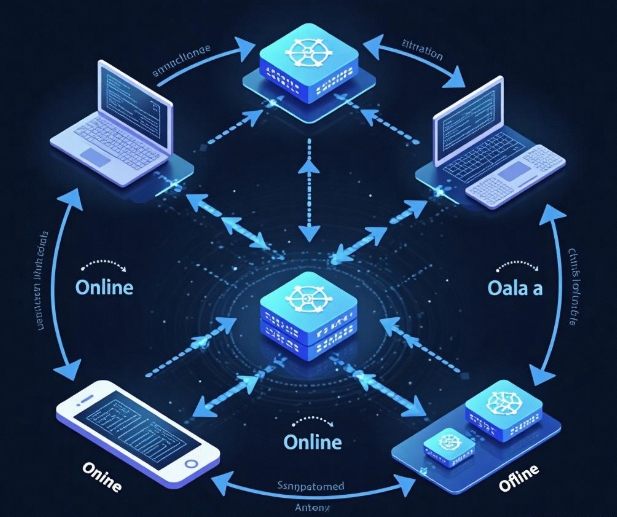Offline Functionality Design and Data Synchronization in Mini-Program Development
- latest articles
- 1.DApp Development & Customization: Merging Diverse Market Needs with User Experience 2.Analysis of the Core Technical System in DApp Project Development 3.How to achieve cross-chain interoperability in Web3 projects? 4.How does the tokenization of points reconstruct the e-commerce ecosystem? 5.How to Set and Track Data Metrics for a Points Mall? 6.What is DApp Development? Core Concepts and Technical Analysis 7.Inventory of commonly used Web3 development tools and usage tips 8.Development of a Distribution System Integrated with Social E-commerce 9.Six Key Steps for Businesses to Build a Points Mall System 10.What is DApp Development? A Comprehensive Guide from Concept to Implementation
- Popular Articles
- 1.Future Trends and Technology Predictions for APP Development in 2025 2.Analysis of the DeFi Ecosystem: How Developers Can Participate in Decentralized Finance Innovation 3.From Zero to One: How PI Mall Revolutionizes the Traditional E-commerce Model 4.DAPP Development | Best Practices for Professional Customization and Rapid Launch 5.Recommended by the Web3 developer community: the most noteworthy forums and resources 6.From Cloud Computing to Computing Power Leasing: Building a Flexible and Scalable Computing Resource Platform 7.How to Develop a Successful Douyin Mini Program: Technical Architecture and Best Practices 8.Shared Bike System APP: The Convenient Choice in the Era of Smart Travel 9.How to Create a Successful Dating App: From Needs Analysis to User Experience Design 10.From Design to Development: The Complete Process of Bringing an APP Idea to Life
With the rapid development of mobile internet, mini-programs, as a lightweight application form, have gradually gained favor among various users and developers. The emergence of platforms like WeChat Mini Programs, Alipay Mini Programs, and Baidu Mini Programs has made mini-programs an important direction for enterprises and developers to innovate and realize their products. However, the design of offline functionality and data synchronization issues in mini-programs have always been key technical challenges that need to be considered during development.
This article will delve into how to design offline functionality during mini-program development and how to achieve efficient and reliable data synchronization. The content will cover the design requirements for offline functionality in mini-programs, technical difficulties, common implementation solutions, and data synchronization strategies in practical applications, helping developers better understand and solve such problems.
I. Design Requirements for Offline Functionality in Mini-Programs
The offline functionality of mini-programs, as the name suggests, refers to the ability of a mini-program to continue providing certain basic services and functions to users when there is no network connection or the network connection is unstable. For mini-programs in certain scenarios, the design of offline functionality is crucial. For example, when traveling, users may be in areas with poor network coverage. If the mini-program lacks offline functionality, users will be unable to continue using related services, leading to a significant decline in user experience.
The design of offline functionality is not merely about "not crashing after disconnection"; it often involves the following requirements:
Data Caching: Mini-programs need to cache a certain amount of data locally on the device to ensure users can still access some core data or content when offline. This includes user personal information, history records, offline-accessible pages, etc.
Interface and Interaction Fluidity: Even without a network connection, the mini-program's interface and interactions must remain smooth. This requires developers to consider interface performance that does not rely on real-time network requests during design.
Operation and Storage of Offline Data: Users may perform some operations while offline, such as modifying personal information, submitting comments, etc. How to save these offline operations and synchronize them to the server becomes an important part of offline functionality design.
Seamless Data Synchronization: One of the core aspects of offline functionality is the ability to seamlessly synchronize data generated during the offline period to the server once the network connection is restored, ensuring data consistency and integrity.
II. Technical Challenges in Offline Functionality Design
Although offline functionality plays an important role in enhancing the user experience of mini-programs, there are many challenges in the technical implementation process. Here are some common technical difficulties developers encounter when designing offline functionality for mini-programs:
Local Storage Capacity and Efficiency: Mini-programs need to store a large amount of data locally when offline, which imposes requirements on the device's storage space and storage methods. How to ensure efficient and secure data storage without occupying excessive storage resources is a problem that needs to be solved urgently.
Data Consistency and Conflict Resolution: While offline, users can perform various operations, such as modifying data for a certain entry. During the user's offline period, other users or devices may also modify the same data. Once the user's network connection is restored, ensuring that different versions of the data can be correctly merged and data conflicts resolved is a major challenge in data synchronization.
Complexity of Network Environment: The mobile network environment is complex, and the user's network status may fluctuate. How to ensure the reliability of offline data synchronization and prevent data loss or corruption when facing unstable networks is another challenge in offline functionality design.
Optimization of Synchronization Strategy: After the network is restored, how to efficiently synchronize operations and data from the offline period while reducing network requests and bandwidth waste is an important consideration for ensuring system performance.
III. Common Implementation Solutions for Mini-Program Offline Functionality
To implement offline functionality in mini-programs, developers need to utilize specific technologies and tools for development and design. Here are some common implementation solutions for offline functionality.
1. Local Caching Mechanism
The foundation of mini-program offline functionality is local caching. In mini-program development, developers can use the local storage APIs provided by WeChat to cache data needed for offline use. WeChat Mini Programs offer multiple local storage interfaces, such as wx.setStorageSync(), wx.getStorageSync(), wx.removeStorageSync(), etc.
These interfaces help developers cache user data or pages into the local device's storage. Generally, the content cached for offline use includes:
User authentication information, login status;
User browsing history, cached page content;
Records of offline operations, such as user's unsubmitted data.
Through reasonable caching design, the availability of some mini-program functions can be ensured even when the user has no network connection.
2. IndexedDB and Web Storage
In addition to the native storage interfaces of WeChat Mini Programs, developers can also utilize the browser's Web Storage or IndexedDB to store large amounts of structured data. Especially IndexedDB, which supports storing complex objects locally and provides more efficient retrieval and update operations.
As a database-level local storage mechanism, IndexedDB is very suitable for storing offline data. It allows storing more complex data structures, supports transaction operations, and can better handle offline data requirements in mini-programs.
3. Service Worker
In modern web applications, Service Worker is an important technology for implementing offline functionality. A Service Worker is a script that runs independently of the main page thread and can intercept requests and respond with offline caches. Although the support in WeChat Mini Programs is currently limited, some developers have implemented similar offline caching mechanisms in mini-programs using analogous technical frameworks.
Through Service Worker, mini-programs can intercept network requests when offline and return data directly from the cache, which is very helpful for achieving offline access and functionality.
4. Offline Operations and Data Synchronization
Offline operations refer to data modification operations performed by users while offline. These operations cannot be immediately synchronized to the server but are saved locally and synchronized once the network is restored. To ensure data integrity and consistency, developers need to design a data synchronization mechanism.
A common method for data synchronization is incremental synchronization, where only the data that has changed during the offline period is synchronized to the server. For data that needs synchronization, developers can set up a synchronization queue and upload this data one by one whenever the network is restored. To prevent data conflicts, developers need to design conflict resolution strategies. Common practices involve using timestamps or version numbers to determine data priority and resolve conflicts.
5. Handling Offline Data Conflicts
During the process of offline data synchronization, data conflicts may occur. For example, a user modifies the content of an entry while offline, but when the network connection is restored, the data on the server has already changed. At this point, developers need to design a conflict resolution mechanism.
Common conflict resolution strategies include:
Timestamp Conflict Resolution: If two versions of the data have timestamp fields, developers can determine which version is more recent based on the timestamp.
Version Control: By adding version numbers to track the modification history of data, ensuring that more important data is not overwritten during synchronization.
Manual Intervention: For particularly complex data conflicts, users can be provided with the option to manually select the appropriate data version.
IV. Best Practices for Mini-Program Offline Functionality and Data Synchronization
In actual development, the design of offline functionality and data synchronization can be flexibly adjusted according to project requirements. Here are some best practices to help developers better implement offline functionality and data synchronization in their projects.
Design a Reasonable Local Storage Strategy: The local storage space of mini-programs is limited. Developers need to reasonably plan the types of data to cache and the caching strategy to avoid storing excessive useless data.
Synchronize Data in Batches: To prevent too many data synchronization requests from affecting system performance, it is recommended that developers design a batch synchronization mechanism, uploading data generated during the offline period in batches based on priority and size.
Fault Tolerance and Retry Mechanism: When the network is unstable, developers can design a retry mechanism for failed data uploads to ensure that offline data is eventually synchronized to the server.
User-Friendly Prompts and Interface Design: When offline, users may feel confused, so it is necessary to design friendly prompt messages to inform users of the current offline status and synchronization status.
V. Summary
The design of offline functionality and data synchronization for mini-programs is a complex but crucial process. With the continuous advancement of network technology and the ongoing improvement of mini-program platforms, more and more mini-program developers are beginning to prioritize the implementation of offline functionality. By reasonably designing local storage, synchronization mechanisms, conflict handling, and other solutions, a smoother and more seamless user experience can be provided. We hope this article provides valuable reference for mini-program developers in the areas of offline functionality design and data synchronization.
-

How to Increase User Stickiness and Activity Through Mini Program Development
With the development of the internet and mobile internet, mini-programs, as an e···
-

How can mini-program development assist in corporate marketing and e-commerce transformation?
In today's rapidly evolving mobile internet landscape, corporate marketing and e···
-

Offline Functionality Design and Data Synchronization in Mini-Program Development
With the rapid development of mobile internet, mini-programs, as a lightweight a···

 Blockchain
Blockchain












